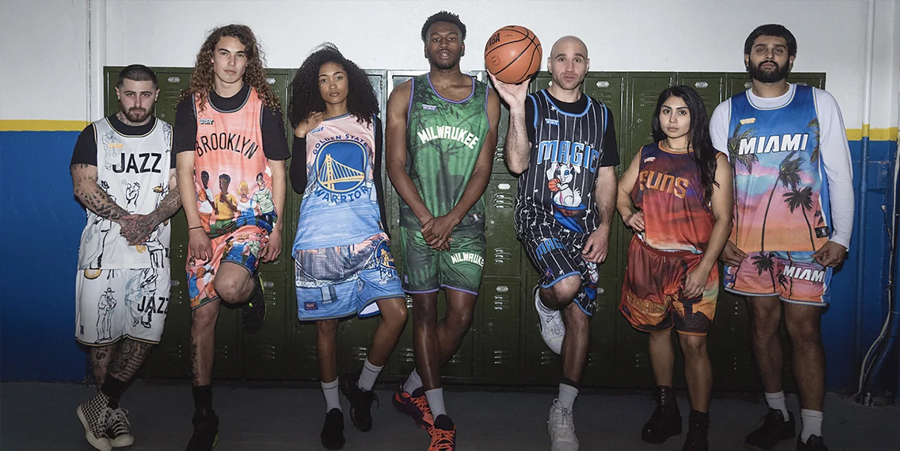CALA’s technology uses AI tools to design, manufacture, and ship garments, making it easier for independent designers to start their own labels.
For years, I’ve felt a gap in my wardrobe in the months where the cold just begins to creep in here in Boston—a time when you don’t need a heavy duty puffer but you’re not yet ready for a lightweight spring raincoat. In my mind, I’ve been dreaming up the perfect outerwear: It’s a cozy, high-quality oatmeal colored wool that’s cut a little like a trench coat, but it’s shorter, hitting the thigh. It would look put together but also provide the correct amount of warmth. But even though I’ve been searching for it for years, I’ve never found it.
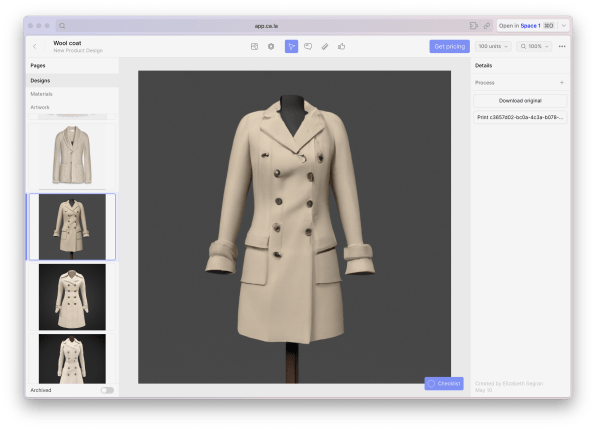
This year, I had an opportunity to design a garment from scratch, so I took the opportunity to create this dream jacket. I used a platform called CALA, which was founded in 2016 and deploys AI and machine learning to streamline the entire fashion supply chain, from brainstorming designs to manufacturing products and pricing them. The company currently has more than 40 brands and independent designers using the platform, including NBA teams and the designer KidSuper.
BRAINSTORMING WITH AI
This service offers a glimpse into how new technologies could make it radically easier for designers to launch fashion brands, by simplifying some of the most complex aspects of making garments. “We have the technology to spin out a Shopify store or build an audience on Instagram,” says Andrew Wyatt, CALA’s founder and CEO. “But it was still complicated to create a physical product. We’re trying to solve for that.”
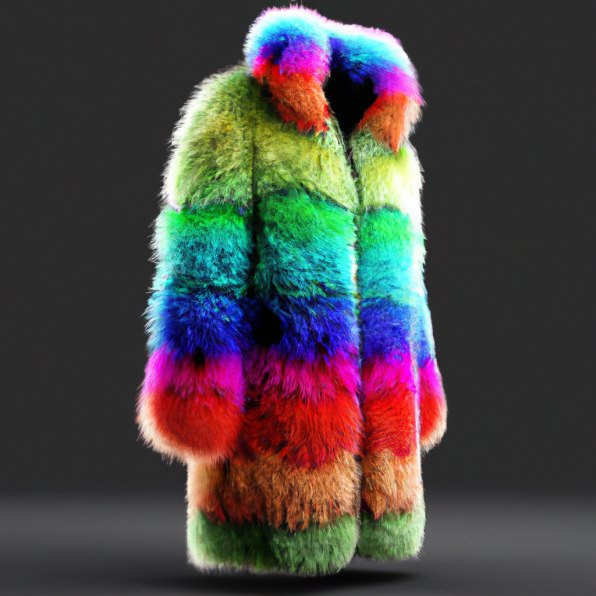
This year, CALA updated its technology to incorporate DALL-E, OpenAI’s system that creates realistic images using natural language descriptions. (OpenAI is also the maker of ChatGPT.) Prior to this, you could upload images of products you were inspired by, creating a kind of “mood board” for your collection. Now, however, you can just use words to describe what you’re looking for. I began writing out details about the jacket I wanted: “oatmeal-colored,” “thigh-length,” “wool,” “trench coat.”
In a click, these descriptions generated six images of a jacket that came close to what I was looking for. None of them were exactly like what I had in mind: One looked too much like a cardigan, the others weren’t the right length. So, the next step was to pick the jacket that came closest to the one I had in mind and ask CALA to keep generating more images like it. I had a fun afternoon doing this, getting closer and closer to my ideal jacket.
The platform makes it easy to work with other people on these designs. You can make notes on each image, then flag other members of your team who can comment on the design, which might help you iterate further on it. And interestingly, the images helped me refine the details of the jacket I wanted.
I saw versions of the jacket I hadn’t imagined before but that I actually kind of liked, including ones with big buttons, cuffs at the wrist, and large, exterior pockets, so I added those descriptions to my prompt. By the end of the session, I had not only designed the jacket I had always wanted—but the AI also prompted me to brainstorm and refine my thinking. “The more different ideas you can generate, the higher the probability you’re going to edit down to something that’s wonderful,” says Wyatt.
The DALL-E image-generation process mimics what happens in design studios. Many fashion brands hire lots of designers who are tasked with sketching out dozens of designs based on a few prompts. Then, the creative director looks through the ideas, picking ones that fit his or her vision, then refine the sketches from there, until they get to the look they want for the season.
“Historically designers had to be able to do beautiful hand drawings,” Wyatt says. “Alexander McQueen and Karl Lagerfeld’s sketches are iconic. But fast forward to Virgil and Kanye, they’re taking photos of things they are interested in, sending them by WhatsApp to their design teams, who then do a mockup in Adobe Illustrator, and kick it back to them. They kind of riff back and forth that way.”
Wyatt’s goal was to reduce the manual labor of creating those sketches, most of which will be discarded. “We found that some fashion brands were having designers pump out 90 design a week,” he says. “With this AI model, one person could easily generate 90 ideas in one afternoon, and quickly iterate on each one.”
This technology, if it becomes widespread, could disrupt the fashion business. Automating so many aspects of the design process could result in brands cutting down on the number of designers they need to do these quick sketches in design rooms. In turn, this could mean fewer jobs for junior designers, who rely on these jobs as they leave design school and begin building their résumé. But Wyatt believes that it could also give young designers the ability to have more autonomy by launching their own small businesses, rather than doing years of apprenticeships at bigger companies.
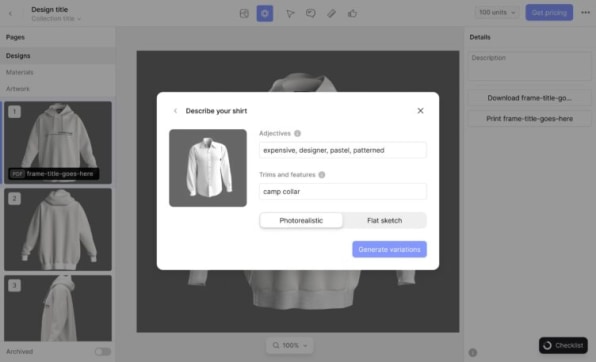
FROM IDEA TO GARMENT
Using AI as a brainstorming tool is certainly helpful. Many people in various fields find that ChatGPT is useful for coming up with ideas. But being able to transform an AI-generated image into a physical garment is a much more complicated proposition—and that’s precisely what CALA allows you to do.
Once you’ve settled on a design that you like, you can begin to turn it into a reality. CALA has relationships with 20 factories in 10 countries around the world, including Vietnam, China, Turkey, Italy, and Portugal. Based on the particular product the user wants to make, the system will determine which factory is a best fit, and incorporate all the information into its pricing algorithm. Products can be turned around in as little as 40 days, if you opt for expedited shipping. “During the pandemic, when one country shut down its production, we were able to send orders to a different country easily, so brands didn’t have delays,” says Wyatt.
With its quick turnaround times, this system could make fast fashion business models more accessible to other brands. This could add to the damage quickly churning out trendy garments is bad for the planet. While CALA doesn’t actively steer brands away from this approach, Wyatt says that it offers tools that allow for more eco-friendly business models as well. The less expensive shipping options take several months to be delivered, and brands can also express a preference to use more sustainable fabrics—like recycled cotton or polyester—as they put their collections together.
The first step is to use the platform’s pricing tool to see how much it would cost to make it. CALA’s algorithms can determine pricing based on how many units you want, incorporating the price of materials, labor, shipping, and even taxes. Then, if you’re happy the suggested price, you can send the designs off to be manufactured.
Once your design is in the factory, the factory managers there will get added to your team and keep you updated about how things are going. They might send you images of prototypes so you can make adjustments, or let you know that the quality control has been done. “We’ve trained all of our factories in our technology,” Wyatt says. “A lot of the people on the ground we work with are Gen Zs and Millennials who are English speaking, which makes the communication much easier.”
Then, when the clothes are ready, they are shipped to the brand’s warehouse, ready to be sent to customers. CALA will even produce images of each garment so it is ready to upload to an e-commerce site.
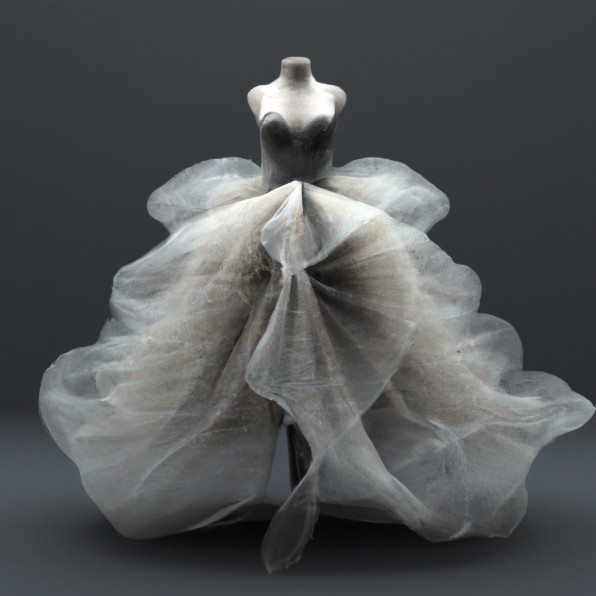
THE FUTURE OF FASHION
CALA streamlines the complex fashion supply chain, allowing designers and brands to create products more easily. Traditionally, fashion brands need to hire a range of specialists from designers to pricing experts to supply chain managers, all of whom are responsible for one part of the process. Wyatt’s goal was to lower the barrier to entry for designers to launch brands.
Today, CALA works with a range of fashion players. Some are small designers eager to get their brands off the ground and start selling collections of their designs. But CALA also works with much larger companies. An enterprise version of the technology allows companies to tailor it to their needs. Some use it just for brainstorming and designing. Others want to be able to send designs to their own factories, so the system is adapted to onboard new manufacturers. CALA charges a $100 monthly fee, along with 15% of the cost of manufacturing, to use its platform. (A simpler version of the platform, that allows only two collaborators, is free.)
But the whole system reveals how technology can make even the most complicated industries more accessible. Now, designers can focus on what they do best—creating compelling and expressive clothing—and leave CALA to worry about sourcing. “Our whole purpose as a company is to power physical product creation,” says Wyatt. “And when new technology becomes available, we can integrate it, so everyone on the platform can benefit from that.”
—
This article first appeared in www.fastcompany.com
Seeking to build and grow your brand using the force of consumer insight, strategic foresight, creative disruption and technology prowess? Talk to us at +971 50 6254340 or engage@groupisd.com or visit www.groupisd.com/story

